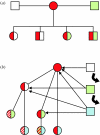Genomic imprinting and the social brain
- PMID: 17118935
- PMCID: PMC1764840
- DOI: 10.1098/rstb.2006.1942
Genomic imprinting and the social brain
Abstract
Genomic imprinting refers to the parent-of-origin-specific epigenetic marking of a number of genes. This epigenetic mark leads to a bias in expression between maternally and paternally inherited imprinted genes, that in some cases results in monoallelic expression from one parental allele. Genomic imprinting is often thought to have evolved as a consequence of the intragenomic conflict between the parental alleles that occurs whenever there is an asymmetry of relatedness. The two main examples of asymmetry of relatedness are when there is partiality of parental investment in offspring (as is the case for placental mammals, where there is also the possibility of extended postnatal care by one parent), and in social groups where there is a sex-biased dispersal. From this evolutionary starting point, it is predicted that, at the behavioural level, imprinted genes will influence what can broadly be termed bonding and social behaviour. We examine the animal and human literature for examples of imprinted genes mediating these behaviours, and divide them into two general classes. Firstly, mother-offspring interactions (suckling, attachment and maternal behaviours) that are predicted to occur when partiality in parental investment in early postnatal offspring occurs; and secondly, adult social interactions, when there is an asymmetry of relatedness in social groups. Finally, we return to the evolutionary theory and examine whether there is a pattern of behavioural functions mediated by imprinted genes emerging from the limited data, and also whether any tangible predictions can be made with regards to the direction of action of genes of maternal or paternal origin.
Figures

Similar articles
-
Imprinted genes and mother-offspring interactions.Early Hum Dev. 2005 Jan;81(1):73-7. doi: 10.1016/j.earlhumdev.2004.10.006. Epub 2004 Nov 19. Early Hum Dev. 2005. PMID: 15707717 Review.
-
The conflict theory of genomic imprinting: how much can be explained?Curr Top Dev Biol. 1998;40:255-93. doi: 10.1016/s0070-2153(08)60369-5. Curr Top Dev Biol. 1998. PMID: 9673853 Review.
-
A model for genomic imprinting in the social brain: adults.Evolution. 2011 Feb;65(2):462-75. doi: 10.1111/j.1558-5646.2010.01115.x. Epub 2010 Sep 29. Evolution. 2011. PMID: 20812976
-
Just how happy is the happy puppet? An emotion signaling and kinship theory perspective on the behavioral phenotype of children with Angelman syndrome.Med Hypotheses. 2004;63(3):377-85. doi: 10.1016/j.mehy.2004.05.010. Med Hypotheses. 2004. PMID: 15288352
-
A model for genomic imprinting in the social brain: elders.Evolution. 2012 May;66(5):1567-81. doi: 10.1111/j.1558-5646.2011.01517.x. Epub 2011 Dec 16. Evolution. 2012. PMID: 22519791
Cited by
-
PD_NGSAtlas: a reference database combining next-generation sequencing epigenomic and transcriptomic data for psychiatric disorders.BMC Med Genomics. 2014 Dec 31;7:71. doi: 10.1186/s12920-014-0071-z. BMC Med Genomics. 2014. PMID: 25551368 Free PMC article.
-
Stress in the Educational System as a Potential Source of Epigenetic Influences on Children's Development and Behavior.Front Behav Neurosci. 2018 Jul 13;12:143. doi: 10.3389/fnbeh.2018.00143. eCollection 2018. Front Behav Neurosci. 2018. PMID: 30057532 Free PMC article. Review.
-
DNMT3A rs1550117 Polymorphism is Associated With Late-Onset Alzheimer's Disease in a Chinese Population.Am J Alzheimers Dis Other Demen. 2016 May;31(3):278-81. doi: 10.1177/1533317515603688. Epub 2015 Sep 14. Am J Alzheimers Dis Other Demen. 2016. PMID: 26371346 Free PMC article.
-
Changes in Stereotypies: Effects over Time and over Generations.Animals (Basel). 2022 Sep 20;12(19):2504. doi: 10.3390/ani12192504. Animals (Basel). 2022. PMID: 36230246 Free PMC article. Review.
-
Introduction. The neurobiology of social recognition, attraction and bonding.Philos Trans R Soc Lond B Biol Sci. 2006 Dec 29;361(1476):2057-9. doi: 10.1098/rstb.2006.1930. Philos Trans R Soc Lond B Biol Sci. 2006. PMID: 17118923 Free PMC article. No abstract available.
References
-
- Alberts S.C. Paternal kin discrimination in wild baboons. Proc. R. Soc. B. 1999;266:1501–1506. doi:10.1098/rspb.1999.0807 - DOI - PMC - PubMed
-
- Albrecht U, Sutcliffe J.S, Cattanach B.M, Beechey C.V, Armstrong D, Eichele G, Beaudet A.L. Imprinted expression of the murine Angelman syndrome gene, Ube3a, in hippocampal and Purkinje neurons. Nat. Genet. 1997;17:75–78. doi:10.1038/ng0997-75 - DOI - PubMed
-
- Arnold A.P, Burgoyne P.S. Are XX and XY brain cells intrinsically different? Trends Endocrinol. Metab. 2004;15:6–11. doi:10.1016/j.tem.2003.11.001 - DOI - PubMed
-
- Barlow D.P, Stoger R, Herrmann B.G, Saito K, Schweifer N. The mouse insulin-like growth-factor type 2 receptor is imprinted and closely linked to the Tme locus. Nature. 1991;349:84–87. doi:10.1038/349084a0 - DOI - PubMed
-
- Barton S.C, Surani M.A, Norris M.L. Role of paternal and maternal genomes in mouse development. Nature. 1984;311:374–376. doi:10.1038/311374a0 - DOI - PubMed
Publication types
MeSH terms
LinkOut - more resources
Full Text Sources

